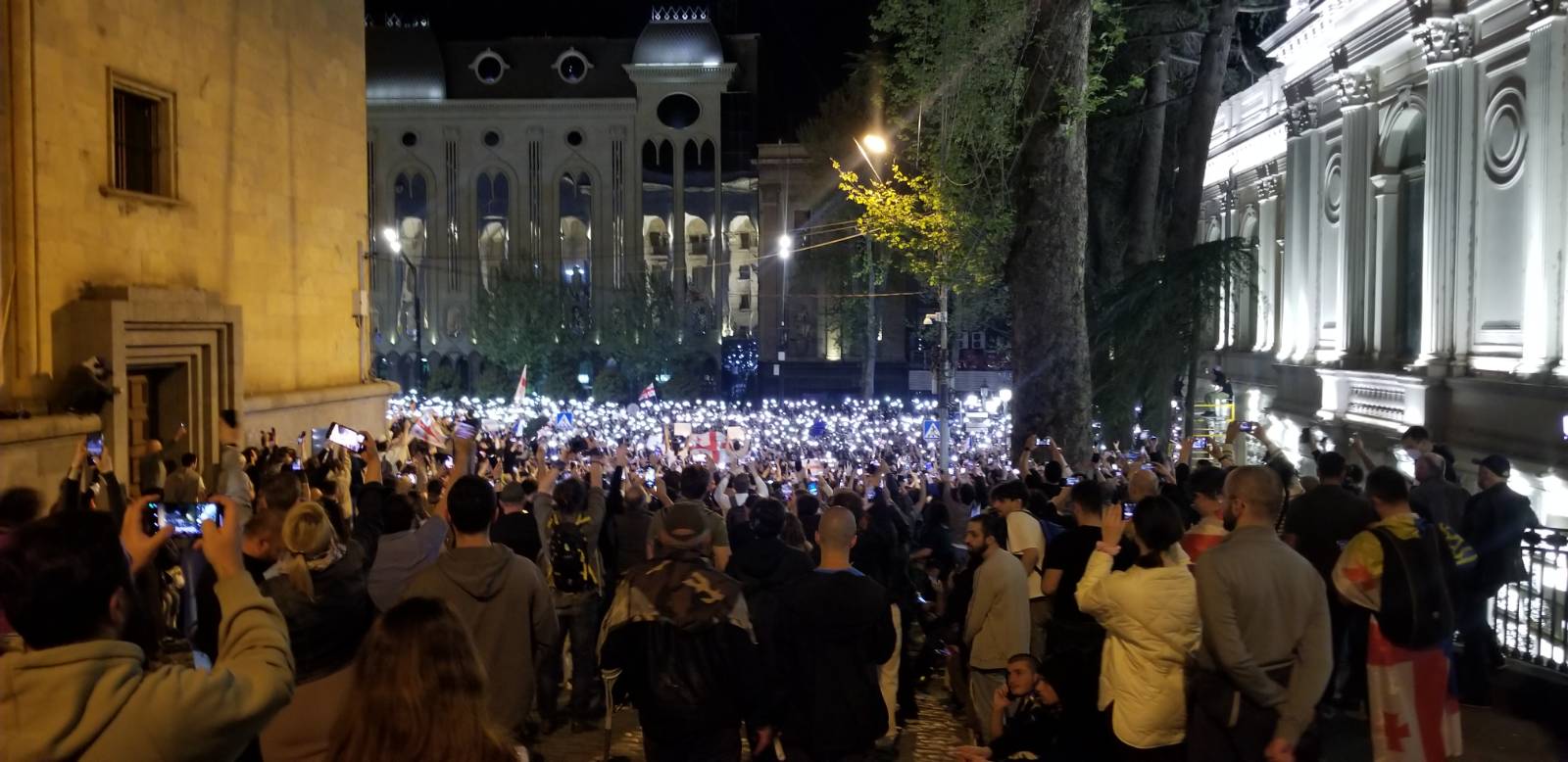Almost two years ago, ‘Notes From the US’ offered a description of fascism to set against how things stood in the United States at the end of the first year after Trump’s disastrous presidency.
Things have moved on.
So this month’s ‘Notes from the US’ is the first of a two-part assessment of how virulent fascism is in the United States. It includes an analysis of what is developing now, why, and how great the dangers are.
Accurate language
It’s all too easy – but pointless – to sling terms like “Fascist!” around as insults. Both Trump and one of his henchpeople, Rudolph Giuliani, have done that recently, which is evidence of their ignorance of history. But, as we shall see, there is also a buzzing psychological dimension to fascism’s appeal. Perhaps – even for these politicians – there may be a chink of doubt which prods them into wanting to denigrate such (barely-acknowledged) ‘fascistic’ tendencies in themselves by vehemently accusing others of having the same trait. Well, No. Probably not. Perhaps it is just ignorance of political science, after all.
In his book ‘Rising Fascism in America’, Anthony DiMaggio uses the distinction between ‘fascistic’ and ‘fascist’. The former refers to a tendency, an implicit but effective endorsement, of the latter. But it is an endorsement that allows its perpetrators (congresspeople, pressure groups, local politicians and so on) to support fascism without the risk of putting voters off if (and it’s a big ‘if’, as we shall see next time) their hoped-for supporters know what ‘fascism’ means.
Our analysis situates American fascism squarely in a ‘democratic tradition’ now rapidly eliding distinctions between three bodies. Until the election of Donald Trump in 2016, there was some overlap between them. Now, there is much less. All three are happily lawless and ruthless. Members of all three are adulatory of Trump. All three believe violent means justify their racist/supremacist, authoritarian and destructive ends.
These three groups are:
• congressional and local (state, county, city) Republicanism. Its supporters wrongly call their ideals ‘conservative’; they are actions which destroy rather than retain. Republicanism has become fascistic in the twenty-first century.
• open, undisguised fascists… the likes of a Richard Spencer or a Mike Enoch.
• extra-parliamentary fascist (para)military groups… The Proud Boys, Oath Keepers, and many others.
The right-wing media almost entirely supports the first; it ignores the second; it’s largely apologetic (“they’re being unfairly victimised”) of the third.
In its way, Trump’s little slogan, Make America Great Again (‘MAGA’), embodies, guides and embraces all three pools. ‘Make’ implies the use of (unwanted) force. ‘Great’ really means nothing except a vague fantasy of supremacy. ‘Again’ implies that America (the rest of the world is excluded) once was whatever ‘great’ means: the myth of the lost ‘golden’ age. And it’s only the ‘MAGA Movement’ which can, and will, restore that ‘greatness’ – probably by coercion and violence.
Fascism
Fascism contains neither a (legitimate) ideology nor a (political) philosophy in the same way as anarchism, socialism, communism, trade unionism and similar movements with beneficent aims. So, the fallacies and deceitful tenets on which fascism is based can and will never evolve. Slogans and misprisions don’t mature.
Yet the uptake and adoption of fascist(ic) systems of oppression, deceit and misery wax and wane. The strength and influence of fascist(ic) infection appear to grow in the United States and elsewhere. One can identify milestones for this uncoiling of the contagion: rallies, interviews, elections, and speeches. Trump is renowned for goading his opponents and challenging the legal system to see how far he can push. This establishes new ‘inflection points’. The 24-hour ‘news cycle’ has as large a part to play in pinning these steps towards the fascism on a timeline.
Such leaning to the right and into authoritarian intolerance and demolition should not be compared to or with (the effects of) Fascism in the 1920s and 1930s in Italy and Spain or Nazism in the 1930s. But much of the impetus behind those movements can be detected in the 2020s for what it is.
Inadequate Analyses
Robert Reich is a former Secretary of Labour and is now a professor of public policy at the University of California, Berkeley. Even his recent ‘soft’ analysis of US public life is illuminating. He has no problem using the ‘F word’. Nor do sites like this; they use the designation ‘Fascist’ rather than ‘Republican’ to indicate party affiliation. ‘Establishment’ left-leaning cable news outlets like CNN and MSNBC, which are regulated – albeit loosely – by the Federal Communications Commission (FCC), increasingly feature interviewees (usually African American or (presidential) historians) who do not stint to talk about the present danger as an ‘authoritarian’ or ‘fascist’ one. They even occasionally refer to Trump and DeSantis with a concern analogous to and redolent of the past, the 1920s and 30s.
Yet such analyses miss something important.
Past occurrences are relevant. To allude to them is appropriate. But the European and Japanese fascism of a century ago, Trump’s wilful hatred and bigotry, DeSantis’s racism, homophobia and fear of those unlike him and his adherents have not wafted in on a surprise ‘ill wind’ by chance. The diseases on which they’re borne have logical and explicable origins. One wonders how often commentators will describe them as ‘un-American’ before giving up and admitting that they are anything but.
Commentaries from other establishment politicians like former US Secretary of State Madeleine Albright ignore that current trends towards building fascism are the next logical step for global capitalism.
Pre-existing conditions produce fascism.
Sinclair Lewis’s warning that fascism could take root in the United States, ‘It Can’t Happen Here‘, was written at a time (mid-1930s) when Charles Coughlin was broadcasting openly fascist, racist and pro-Nazi commentary on US radio to millions – and appeared to have an influence on opinion, not to mention voting patterns. However forcefully Lewis commends us to take notice, it suggests an element of the unexpected in the rise of a ‘populist’ dictator in America.
Democracy
Even a thinker like Jason Stanley is more concerned with fascism’s mechanics and manifestations than its origins. Remove the fascist threat to restore/retain democracy. The defects of this wish are a bit close to home. If examined more closely, the entire basis of the United States polity would potentially be undermined. Such a conclusion holds few or no fears for anarchists. But it would be at least soul-destroying if the American people had to deal with it.
What is called ‘democracy’ in the United States is merely the co-opting of ‘civil rights’, ‘equal opportunities’ and similar top-down legislative initiatives to turn the ‘democratic’ machine to the advantage of the elite that controls it. ‘Democracy’s apologists and practitioners appear willing to embrace selflessness. But doing so forces the bigotry and psychopathy that fascism feeds underground.
Now, fascistic tendencies are emerging again.
So far, they remain effectively unchallenged by the elite co-opters – for instance, those in the Biden Presidency with their rhetoric about fairness, collaboration and equality.
Organs like the Refuse Fascism movement go further by concentrating on the enormity and imminence of the threat and by admirably documenting its dimensions. In his book ‘On Tyranny’, authors like Tim Snyder set out a comprehensive and valuable historical and theoretical context.
But few resources or movements (we shall be looking at Antifa next month) provide us with one essential tool to understand and resist the threat of fascism: its real origins and causes. What these? And why are they so often overlooked?
Cult
Even those whose stance towards ‘democracy’ extends no further than misgivings should be alarmed at one specific behavioural trait of followers of Trump and his milieu: hero worship. Members of all three constituencies identified above praise and show adulation for the would-be dictator and what he stands for – either because MAGA promises what the cult members want or merely because of Trump’s power or (usually physical!) appeal. Or both.
Fascism relies on a cultish adoration of and allegiance to a single man (it almost always is a male; Italy now is an exception), which is so fulsome that the adorers cannot see his flaws. Or if they can, his crimes, narcissism, lies and bigotry don’t matter to the cult’s members. Many recent polls (like this one) convincingly show that Trump’s grip on the Republican party and its direction and prospects is unassailable. He can do no wrong. That is dangerous in assessing anyone knowledgeable, sensitive and thoughtful – if for no other reason (and there are many others, of course) than that no one is infallible.
Either a significant minority or an actual majority of those who intend to vote Republican in the future cannot conceive of any reason why they would ever discard Trump. Although he has been impeached twice, is indicted with 91 individual charges against him four times, and has cost their party three major elections!
Regardless of the stamp or substance or (lack of) ‘ideals’ that such a figure had, slavish allegiance to a single figure is always suspicious at best. Jungian theorist Helton Godwin (aka ‘Peter’) Baynes (1882 – 1943) advanced a theory which may at first seem hard to swallow, counterintuitive. In his book 1941, ‘Germany Possessed’, Baynes suggests that such cult figures as Hitler, Stalin, and Mao (the C20th’s most prolific mass murderers) attract followers as dictators. Rather, they appear (also) to command absolute obeisance because of what they represent, regardless of who they are. For Baynes, Hitler stood for the dark side of civilisation, the worst which a connected society can throw up.
As children, weren’t we as curious about tapping in the cupboard, which we couldn’t see in the dark at bedtime, as we were frightened of it? Didn’t we fuss with our tongue at the loose baby tooth as much because it represented something hidden and potentially painful, of which we needed to be part? If Trumpers go all out for such a vile, misogynistic, racist, lying, psychopathic narcissist, couldn’t they, in part, be like children exploring the (physical) boundaries of their world? Isn’t knowing how far toys can be thrown from the pram before they fail to be returned to it and to us useful?
Suppose Baynes had been diagnosing Covid deniers in the 2020s. Mightn’t he have said that the refusal by large swathes of folk on the right to be vaccinated was an (analogous) application of ‘exploratory’ impulses? That such insistence was just a sign of masculinity and a rejection of ‘wimpish’ weakness? Followers are brainwashed into embracing danger – self-destruction even – in order to convince their peers (and almost certainly themselves) of their fealty to the ’cause’.
Political science may well have little of this, but – as we examined in the previous ‘Notes from the US‘ – thinkers like Umberto Eco emphasise the (self-)sacrificial nature of fascism. Indeed, in 1938 the historian Hugh Trevor-Roper remarked on the Nazis’ “readiness to suffer martyrdom in the attempt to force it on us”. Fascism has strong streaks of masochism-as-gesture. This is but a short distance from the (sublimated) self-hatred, as examined by William Reich in his study of fascism in the 1930s. An even shorter step is that from hatred of self to hatred of others.
Psychology may explain why an authority figure can be so attractive to cult members. He (again, almost always male) may seem to them to satisfy an unmet need. Jung would turn this on its head and emphasise the positive: the advisability and benefits of ‘self-correction’. This best comes from ceasing to repress our ‘shadow’ or ‘inner negative’ tendencies. Stand back in order to take one last step – for if we ignore the worst of which our society is capable, (how) can we ever confront it?
Perhaps Jung, Baynes and the psephologists might meet in an examination of the incomplete and inadequately satisfied need for a powerful male to remove those whom the cult members can’t, won’t, or don’t know how to tolerate. That such a need is (partly) unconscious and submerged only serves to strengthen it. The ‘other’ just can’t be understood, so it has to be disparaged or eliminated. Only then – perversely – can we face and truly accept the ‘other’; maybe also accept ourselves.
One theory gained widespread currency and acceptance on the left after Trump’s (to many surprising) election in 2016. That he represented the ‘dispossessed’ white lower middle class, it was suggested that their support was based on the hope that he could meet their (poorly or unarticulated and overlooked) economic needs and positively affect their material prospects. But such studies as this now persuasively suggest that Trump’s strongest support comes not from areas of perceived depression and economic decline in rural America. But that it comes from whites who are relatively affluent and live in the (expanding) suburbs. To be sure, those suburbs are increasingly enriched by racial diversity. So, unsurprisingly, many voters saw Trump’s racism as a plus; they hoped he would recreate a white America (again). So, after all, it seems likely that MAGA appeals more to self-deceit and to an investment in someone who can defeat the playground bully, not who can hand out more cake and sweets to them all.
Social Darwinism
Another bellwether of fascism is Social Darwinism. The movement must send the weaker and more vulnerable to the wall. Aiding, supporting and providing biological dead ends with a chance of surviving is a waste. Fascists try to advocate the preservation and prosperity of a population group of which they approve and of which they are a part or like to think they are or hope to be someday. Just as Hitler slaughtered millions in the interest of advancing or creating a Herrenrasse (master race), so – in reaction to the latest uptick in Covid cases – Trump bellows that he will “not allow” masks or vaccines. In a disturbing speech last weekend, he accused his opponents of trying to restart “Covid hysteria”. His aim was to promote (what he sees as the validity of) ‘evolutionary’ sadism.
He is not alone. (Arkansas is also the state where pupils, as they began their school year last month, found one major opportunity for learning and expansion of tolerance denied them. At the dictate of the Arkansas Department of Education, AP (‘Advanced Placement level taught at high school for undergraduate credit) lessons in African American history are no longer allowed.)
The refusal to employ sound public health policies in the face of a renewed threat by what all of us can only hope is a brief (and statistically not uncommon) resurgence, and last gasp of Covid 19 is an effort to ensure that the pure American race will be better off if the old and vulnerable are left to die. The perceived rationale is to be examined for two days in December at a conference organised by the Natal group. Natal is composed largely of fascist, racist, supremacist and eugenicist pundits and media. For instance, the event’s organiser, Kevin Dolan, has been associated with several far-right movements which seek to control (the North American) population along racial lines.
Similarly, in Florida this month, Governor DeSantis endorsed the deadly advice based on lies of his unqualified and mendacious surgeon general. Joseph Ladapo wants Floridians to refuse vaccinations as protection against Covid. Florida recorded its 90,000th death from Covid in the same week; the number of reported weekly new cases was nearly 24,000 for the second week running – a 300% increase. As state senator Tina Polsky said in response, “The surgeon general is lying to people and scaring people, and the effect is going to be that more people are going to die from Covid.” Other Trumpy states like Texas – as well as Trump himself – are committed to bringing about as many deaths as they can either by actively discouraging accepted public health measures or by prohibiting them outright or both.
Again, there may be a psychological component parallel to Freud’s Todestrieb (death wish). Aldous Huxley developed a similar idea in what must have included his attempt to understand the enormities of the Second World War, writing ‘… It is as if devils possessed them… doing things they know are fatal, that they know are wrong, doing them in spite of that knowledge or perhaps actually because of it…’
There could also be a feeling that – by defying common sense and surviving – the anti-vaxxers boost their sense of having defiant powers. Such denial probably (also) operates along the lines, “I don’t want to become ill. Covid actually makes people ill. So I won’t recognise its dangers; then I won’t have to feel something I don’t want to feel”. The same surely applies in the case of climate collapse denial.
Them and Us
Fascism relies on its leaders’ exploitation of followers’ traumas and senses of inadequacy. “Maybe the dictator can make me strong and banish the monster under the bed”. This goes a long way towards explaining how fascism can be so powerful – even though it is not a (well) thought-out ideology. It’s not based on actual ideas, evidence or realities. It fails to call on the intellect and awareness of political science and history.
What’s more, such a vapid ragbag of slogans and misunderstandings of what constitutes a happy life uses its followers’ perceived identities of self to exploit perhaps the most basic of fascism’s tenets: division. Cult followers seem to believe that the ‘benefits’ that fascism (and even fascistic trends) can confer (health, power, racial purity and so on) are limited. Someone has to go without.
There is a recognisable sequence to promote such distortions.
First, the articulation and pseudo-justifications of racial superiority.
Then, the adulation of those thought to be able to act on it and deliver the elimination of inferiors based on feelings of vaunted supremacy over ‘the other’.
The perceived need to distinguish between the peer group (The Republican party, ‘patriots’, white males and so on) and everyone else becomes increasingly obsessive and constant.
Supremacist sentiments emerge in cases like this, where black pupils appear to have been singled out for criticism and humiliation on account of their race, not their perceived achievement in schools, in a state (Florida) where the elite is aggressively pushing a racist agenda. These are far from isolated incidents. Attempted suppression of identity in order to advance the notion that, for example, “white is best” abound. In Tennessee, recently, the majority party once again voted to remove an outspoken black representative. Not far away, a black child was effectively killed because a fascistic governor whom some are calling the ‘madman of Texas’, Greg Abbott, is still trafficking needy guest worker families to Democrat-controlled cities with no regard for their safety in order further to demonise the ‘illegal other’.
Nearly a quarter of the way through the twenty-first century, the combined forces of the right seem to be confident that a goodly number of people in the US happily and energetically accept this division between ‘them and us’.
Next comes action as a consequence. We have already seen such action; others seem imminent: coup, election fraud, racist attacks, threats to – even eventually assassinations of – opponents, blatantly unlawful action and a Republican party with a legislative agenda designed to meet the needs of such a tiny minority – and one which ignores climate, poverty, personhood, equality, health so demonstratively as to be almost a caricature of government, which is just what we expect as anarchists.
Such action is claimed to be necessary to become the means to justify the ends if America is to be “saved” from its many enemies: Marxist governors and judges, fake media, communist agitators, Black Lives Matter, Antifa, radical left-wing members of Congress, lunatic members of a corrupt Department of Justice.
The slide into fascism begins with ‘patriotism’ and moves through nationalism to racism. Then (in the case of the Third Reich), it leads to war with the aim of world domination. Americans are brought up to ‘love their country’. Even the most apparently ‘liberal’ of public figures, when meeting or interviewing a US military member, will make a point of thanking them for their ‘service’.
If this reasoning is accepted, we appear to be at a juncture where the shift onwards from aggressive acquisitiveness and coercion (global capitalism à la United States) is both logical and (seems) inevitable. Fascism at this point is neither aberration nor surprise; neither ‘unAmerican’ nor a temporary departure from what most people have grown up to perceive as ‘the norm’.
Significantly (and predictably for anarchists), the vast bulk of measures taken since Reconstruction have all led in a roughly similar direction. There have not been twin (or multiple) strands of policy or vision to oppose the excesses of global capitalism. Government has meant two sides of the same coin. This monolithic conception of governance lies at the heart of how and why the United States is where it is now.
Next time, we’ll unpack the context and cause of this proposition.
~ Louis Further
Image: Rod Webber








